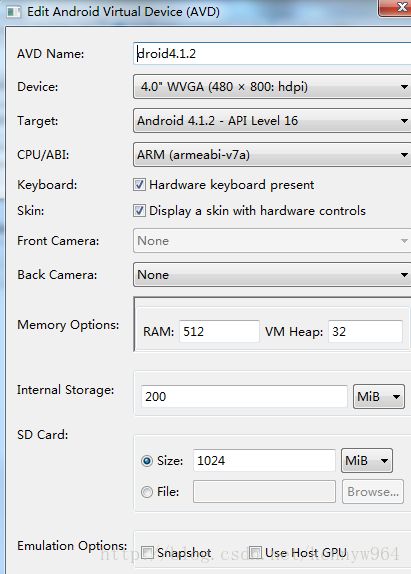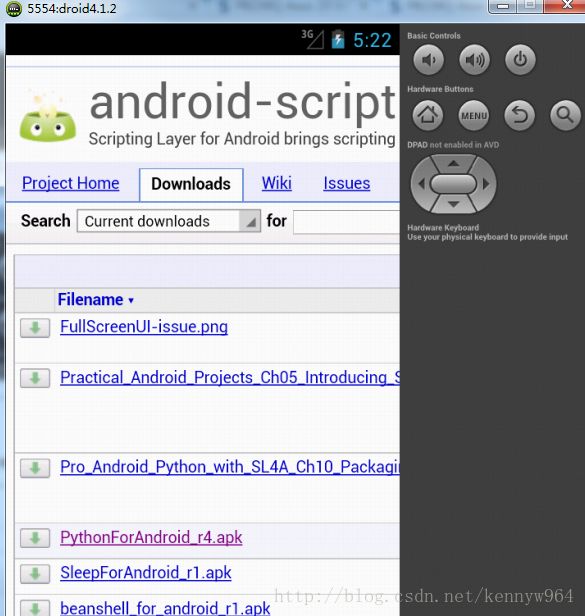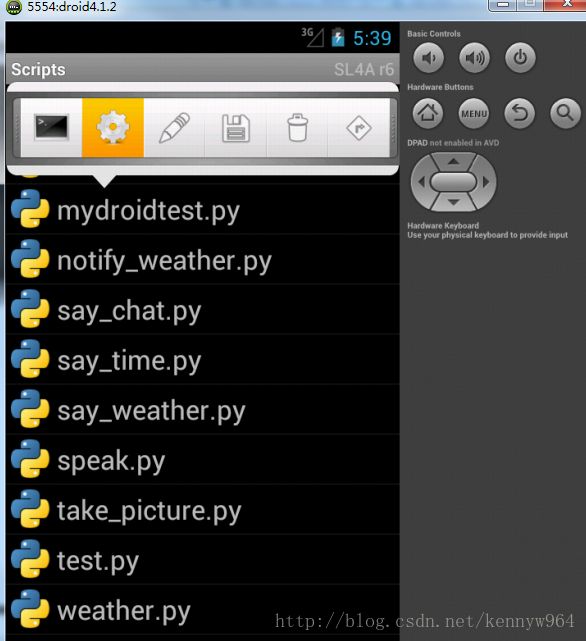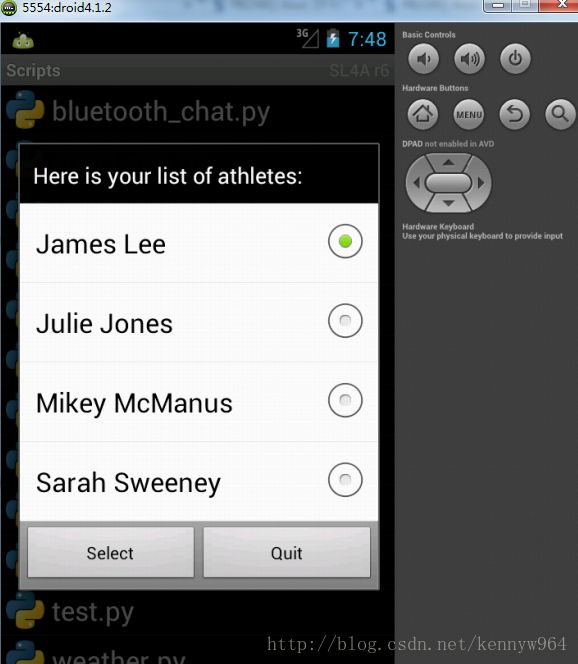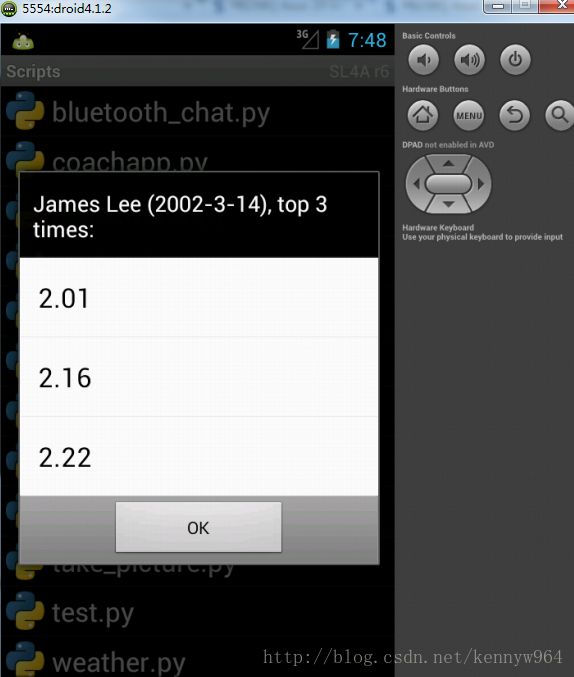python系列学习六——移动开发
1. SDK下载
SDK下载地址
注:该SKD需要预先安装jre(Java Runtime Environment)
2. 配置SDK和模拟器
打开 SDK Manager,安装所需要的packages:
选择Tools-->Manage AVDs,添加一个新的Android虚拟设备(AVD):
3. 安装配置android脚本环境
打开模拟器设备,点击模拟器的浏览器,导航的下面地址:
https://code.google.com/p/android-scripting/
点击二维码图片,下载SL4A包并安装,安装完成后回到浏览器,选择Downloads标签页,下载安装python_form_andorid_rx.apk.
安装完成后打开该软件,点击Install,下载解压安装面向Android的Python支持文件(这个过程不要点击屏幕任何地方)。
至此 ,Python2.6.2和Python for android都已安装在模拟器中。
4. 测试Python
编写脚本mydroidtest.py:
import android
app = android.Android()
msg = "Hello from head first Python on android"
app.makeToast(msg)adb push mydroidtest.py /sdcard/sl4a/scripts如图,模拟器正常运行所编写的代码。
5. json模块
json.dumps() encode data with json format
json.loads() decode json data to orogin data
6. android应用
webapp中的模块athletemodel添加get_names_from_store()方法:
import cPickle as p
from athletelist import AthleteList
def get_coach_data(filename):
try:
with open(filename) as f:
data = f.readline().strip().split(',')
return AthleteList(data.pop(0), data.pop(0), data)
except IOError as err:
print 'File error: ' + str(err)
def put_to_store(the_files):
athletes = {}
for f in the_files:
ath = get_coach_data(f)
athletes[ath.name] = ath
try:
with open('athletes.pickle', 'w') as athf:
p.dump(athletes, athf)
return athletes
except IOError as err:
print 'File error(put_to_store): ' + str(err)
return None
def get_from_store():
athletes = {}
try:
with open('athletes.pickle') as athf:
athletes = p.load(athf)
return athletes
except IOError as err:
print 'File error(put_to_store): ' + str(err)
return None
def get_names_from_store():
athletes = get_from_store()
name_list = [athletes[ath].name for ath in athletes]
return name_listathletelist添加to_dict()方法,将athlete数据转换为字典:
class AthleteList(list):
def __init__(self, a_name, a_dob=None, a_times=[]):
list.__init__([])
self.name = a_name
self.dob = a_dob
self.extend(a_times)
@staticmethod
def sanitize(the_time):
if '-' in the_time:
splitter = '-'
elif ':' in the_time:
splitter = ':'
else:
return the_time
(mins, secs) = the_time.split(splitter)
return mins + '.' + secs
def top3(self):
return sorted(set([self.sanitize(t) for t in self]))[0:3]
def to_dict(self):
return {'name': self.name,
'dob': self.dob,
'top3': self.top3()}新建python cgi脚本generate_names.py,获取athlete names的json数据:
# coding=utf-8
import yate
import athletemodel
import json
import cgitb
cgitb.enable()
names = athletemodel.get_names_from_store()
print yate.start_response('application/json')
print json.dumps(sorted(names))# coding=utf-8
import cgi
import yate
import json
import athletemodel
form_data = cgi.FieldStorage()
athlete_name = form_data['athlete'].value
athletes = athletemodel.get_from_store()
print yate.start_response('application/json')
print json.dumps(athletes[athlete_name].to_dict())编写android脚本程序coachapp.py:
# coding=utf-8
import android
import json
import time
from urllib import urlencode
from urllib2 import urlopen
hello_msg = "Welcomd to Coach Kelly's Timing App"
list_title = "Here is your list of athletes:"
quit_msg = "Quitting Coach Kelly's App."
web_server = "http://192.168.115.1:8080"
get_name_cgi = "/cgi-bin/generate_names.py"
get_data_cgi = "/cgi-bin/generate_data.py"
def send_to_server(url, post_data=None):
"""该函数取一个url和一些可选数据,向web服务器发送一个web请求,web响应返回给调用者"""
if post_data:
page = urlopen(url, urlencode(post_data))
else:
page = urlopen(url)
return page.read().decode('utf8')
app = android.Android()
def status_update(msg, how_long=2):
"""显示简短消息提示"""
app.makeToast(msg)
time.sleep(how_long)
# 显示欢迎消息
status_update(hello_msg)
# 将web请求发送给服务器,把json相应转换为一个有序列表
athlete_names = sorted(json.loads(send_to_server(web_server+get_name_cgi)))
# 创建一个包含两个按钮的对话框
app.dialogCreateAlert(list_title)
app.dialogSetSingleChoiceItems(athlete_names)
app.dialogSetPositiveButtonText('Select')
app.dialogSetNegativeButtonText('Quit')
app.dialogShow()
# 等待用户点击一个按钮,把结果赋给resp
resp = app.dialogGetResponse().result
if resp['which'] in ('positive'):
selected_index = app.dialogGetSelectedItems().result[0]
selected_name = athlete_names[selected_index]
athlete = json.loads(send_to_server(web_server+get_data_cgi, {'athlete': selected_name}))
athlete_title = athlete['name'] + ' (' + athlete['dob'] + '), top 3 times: '
app.dialogCreateAlert(athlete_title)
app.dialogSetItems(athlete['top3'])
app.dialogSetPositiveButtonText('OK')
app.dialogShow()
resp = app.dialogGetResponse().result
# 显示退出消息
status_update(quit_msg)小结:
1)Json库模块允许将Python的内置类型转换为基于文本的JSON数据交换格式
2)使用json.dumps()可以创建一个Python类型的字符串版本
3)使用json.loads()可以从一个JSON字符串创建一个Python类型
4)如果数据使用JSON发送,需要将其Content-Type:设置为application/json
5)urllib和urllib2库模块可以用来从一个程序向web服务器发送编码的数据(使用urlencode()和urlopen()函数)
6)sys模块提供了sys.stdout和sys.stderr输入流

